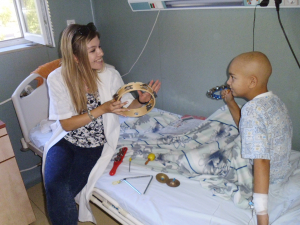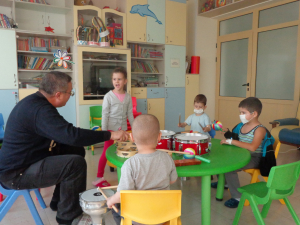
ARTON PROGRAM - The therapeutic power of the group
Creative projects involving group work - general musical performance or group painting, collage, sculpture - are useful in helping to explore and strengthen social...
Children with selective mutism (SM) are talkative at home but unable to speak in more public settings, including school. This guide is for parents and teachers who are wondering if a particular child has SM, or are wondering how to help selective mute kids who have it find their voices.
When children are unable to speak around certain people or in certain settings, they may have an anxiety disorder called selective mutism (SM). It is common for kids with SM to be very chatty at home with family but silent at school. Parents typically start noticing signs of SM when a child is three or four years old. The disorder might not be diagnosed until she is school-aged, when her problems with speaking become more apparent.
A child with SM might go a whole year or more in a classroom without speaking once to her teachers, counselors or peers. Typically, kids with SM are mild mannered and polite in classroom settings, so their silence can be misinterpreted as shyness and never addressed as a possible barrier to their learning. Additionally, pediatricians may tell parents that the “shyness” will pass and discourage families from seeking treatment.
Selective mutism can cause significant impairment in a child’s life. It can interfere with kids’ performance at school, both academically and socially. It can prevent kids from asking for help if they need it, like telling the teacher they need to use the bathroom. And it can prevent kids from engaging in many fun activities that require verbal communication, including play dates. The good news is that with the right help, kids with SM can get better.
Selective mutism is relatively rare, so people, even pediatricians or other specialists, might not immediately recognize it, or might mistake it for autism or a communication disorder. People may also mistakenly think that a child isn’t talking because he is being willful or oppositional.
In reality children with SM are extremely anxious and can’t talk, even when they want to. In other words, a child with SM is unable to speak, not refusing to speak.
There’s also a misconception that kids who can’t speak in some settings have been traumatized. In fact, kids who become mute after a traumatic experience are typically mute in all situations, not specific social environments, as is the case with SM.
Finally, it’s not unusual for relatives to think a child with SM is “just being shy,” and will “grow out of it.” But these kids are much more than shy — they’re frozen with anxiety. The longer a child doesn’t speak in certain settings, the more he will miss out on, and the harder it will be to treat the problem.
The good news is that selective mutism is very treatable with the right care. Kids with SM respond best to behavioral therapy that is focused on helping them learn to speak in new settings, during new activities and with new people.
If you are concerned that your child might have SM, you should get a comprehensive evaluation that establishes a diagnosis. The evaluation should specifically examine the circumstances in which your child is verbal and non-verbal, and if she might have any co-occurring conditions (like other anxiety disorders). An evaluation will also rule out other diagnoses, such as a communication or language disorder, which could also be causing restricted speech.
Children with SM should never be pushed to speak. The pace of treatment should be gradual, and children shouldn’t be asked to do something that is too difficult for them. Instead, treatment should follow specialized behavior therapy techniques that prompt speech and then reinforce successful speaking experiences with lots of labeled praise and small incentives. This careful progression helps children gain confidence and prepares them for experiences that get progressively more challenging.
Intensive behavioral treatment, like the Brave Buddies℠ program, has proved to be very successful in treating SM. Instead of meeting with clinicians for just one hour a week, children in intensive group treatment can participate in daylong or weeklong sessions. This concentrated focus helps jumpstart treatment by giving kids bigger and more immediate gains.
For a treatment program to be effective, kids need to learn how to speak in everyday situations — not just in the doctor’s office. This means that clinicians should model treatment around real life settings and situations. For example, because kids with SM typically struggle to speak at school, the Brave Buddies℠ group program takes place in a simulated classroom and follows a typical school day, with activities like a morning meeting, show and tell and snack time. This helps children bring the speaking skills they are developing with them when they return to their real classroom. “Field trips” during treatment, to places like the park or the ice cream store, are also important, because they help children get practice speaking in actual real life settings where they would typically remain silent.
It’s important that everyone in a child’s life be involved with treatment because SM is a disorder that other people tend to adapt to, which can actually make it harder to treat. For example, if you know that your child gets anxious when ordering at a restaurant, you might automatically answer for her when the waiter asks what she’d like to eat. While your intention is to lessen her anxiety, this pattern of “rescuing” only reinforces the likelihood that she will continue being quiet around waiters.
Instead of “rescuing” kids from their anxiety, parents and caregivers can help them learn to cope as part of their treatment program. Your child’s clinician should provide good strategies and advice for doing this. While her anxiety may not diminish completely, her ability to tolerate her distress will increase.
Kids with SM get too much practice not talking. Think about how many times a day your child is asked questions at school that he is not answering. Treatment helps reverse this by giving kids experience speaking in situations where they feel anxious. Since kids spend more time at home than they do working with a clinician, parents are a vital part of treatment. Clinicians should teach parents how to reinforce the skills kids are learning in therapy. Parents need to learn specific ways to encourage speech and look for opportunities to help kids continue building positive speaking experiences as much as possible.
As part of a comprehensive treatment program, it is extremely important to get a child’s school on board with treatment. Often the first step is helping teachers and administrators at the school understand selective mutism. Many educators haven’t heard of the disorder, and a child’s silence can be mistaken for lack of comprehension or ability, stubbornness or even oppositional behavior. And like parents, teachers can adapt to a child’s silence or get used to other children answering for her, which won’t help her get better.
Teachers should understand what selective mutism is and be trained in the skills and strategies that help kids with SM speak. Your child’s clinician should be able to give specific advice on the best way to work with the school. Clinicians at the Child Mind Institute always collaborate with teachers, provide trainings and offer specific strategies for use in the classroom. Children with SM may also qualify for accommodations under Section 504 or be eligible for special school services under an Individualized Education Plan (IEP).
Behavioral treatment is the gold standard for treating selective mutism, but medication can be helpful for kids with the disorder who aren’t making sufficient gains with therapy alone. Parents should expect to see results relatively quickly from behavior therapy. If a child isn’t improving after a month, parents should consult with a child and adolescent psychiatrist who can prescribe medication.
Most typically a child and adolescent psychiatrist will use a type of antidepressant medication. SSRIs (or selective serotonin reuptake inhibitors) are antidepressant medications that are very effective for anxiety disorders like SM. Unlike fast-acting anti-anxiety medications, SSRIs take several weeks to work, and help children become less inhibited and more able to participate in therapy over the long-term.
Kids may be required to take them for up to 9-12 months so that they experience the full benefit. If your child is prescribed medication, make sure that his therapist is in close communication with the prescribing doctor so they can coordinate treatment and monitor how he’s responding. The prescribing doctor should preferably be a child and adolescent psychiatrist who is familiar with and experienced in treating children with SM.
Treating older kids with SM is more complicated because they have lived with the disorder for longer, but there is still excellent help available for them.
Kids who have had SM for longer will be accustomed to not speaking in public, and their parents, teachers and other caregivers will have adapted to working around their avoidance. To combat these long-standing habits, clinicians will need to put in place a very robust treatment plan, likely using intensive behavioral therapy. Clinicians may also go with children to the actual places where they have difficulty speaking in order to do “real life” treatment.
Kids who are older and have had a longer history of SM are also more likely to be prescribed medication to help them participate in therapy.
Finally, older kids with selective mutism are also more likely to have other disorders, such as social phobia and other anxiety disorders or depression. Other disorders should be treated as well; treatment for SM won’t necessarily make these problems go away.
Selective mutism is more common among children who speak a second language. Being bilingual doesn’t cause SM, but for kids who already have an anxious temperament, being expected to use a language they are less comfortable with can put them at additional risk.
Some bilingual kids may only be silent when they are expected to speak in their second language. For other children, their fear of speaking can be generalized, so that they won’t speak even in their native language.
Diagnosing children who use a second language should be done carefully. Children should not be diagnosed with SM if their failure to speak can be explained by difficulty understanding or using a second language. Bilingual children commonly experience a “silent period” while they are acquiring their new language, so clinicians should be careful not to mistake this stage of learning for SM. Bilingual children also typically begin developing language slower.
What’s the difference between SM and autism or a communication disorder?
Paying attention to when a child is having trouble communicating helps determine if she has SM or something else. While a communication disorder will be apparent in all situations, symptoms of selective mutism are only noticeable in specific social situations. Likewise, kids with autism will have problems interacting socially in all circumstances, not just around certain people or in certain settings.
Can kids grow out of SM?
Experts don’t know how many children with selective mutism will grow out of the disorder. But what we do know is that treating it becomes much harder the older a child is, so it is extremely important not to put off treatment. Additionally, the longer a child isn’t able to speak in certain settings, the longer he will be suffering emotionally, and missing out on important social and academic development.
Would switching classes at school help?
Sometimes switching to a different class or school can help, since your child won’t have a history of not talking there. Even when a child is in treatment, it can sometimes be hard to get her to talk in front of a teacher she has a history of not talking around. The more she is used to not talking in a particular setting, the more ingrained it will be.
However, switching classes doesn’t always work, particularly if that is the only change that you make. If you do decide to switch classes or schools, it is best to have strategies and techniques in place before she makes the change. This might mean doing things like visiting the new classroom and meeting her new teacher before school starts, in a situation where she’s not immediately expected to answer questions or speak. Ideally a new teacher would also be trained in what selective mutism is and how to help kids who have it.
What should I tell my family?
Kids with selective mutism are often unable to speak around some extended family members, which can be stressful for everyone involved, particularly if the SM is mistaken for stubbornness or oppositional or manipulative behavior. Explaining to relatives what selective mutism is and sharing how they can help is important. Some clinicians meet with grandparents and other important members of the extended family to coach them in how to help the child. When family members are included in a child’s treatment, they are usually eager to help him get better.

Creative projects involving group work - general musical performance or group painting, collage, sculpture - are useful in helping to explore and strengthen social...

In the ARTON Program our team of oncopsychologists, art therapists and music therapists develops the process of children's creativity as a process of...

In ARTON sessions, creating a piece of music or a song is an emotional experience of coping and satisfaction for the participating children. They make friends with...

Painting provides patients with a spontaneous, plastic method of depicting thoughts and experiences. Painting with paints is not as structured as with pencil or...










